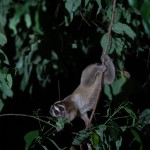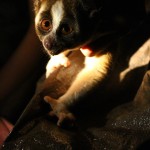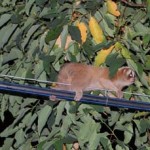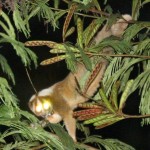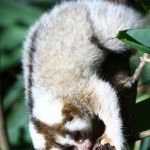Here is a sneak peek of the newsletter, which should be uploaded tomorrow!
The Kukang Klan Part II
Carrying on from the last newsletter, we continue the story of “The Kukang Clan”, the slow lorises that we follow in Cipaganti, West Java
Clever mum
The first thing we noticed about this animal when we started observing her is that she is very fast. This is the reason for her name: Tereh means fast in Sunda language. Or at least we thought she is fast! In the meantime we know that she tricks us. She uses the straight water pipes that run like power lines several meters above the fields as a “motorway” to the faraway places of our study site. Like that she always manages to disappear at one place and appear at a very distant place quickly. Tereh is also the mother of Tahini.
“The belt”
Tahini has not been caught yet because she is still too young. Over the last weeks, she has become less and less fluffy, until now she has only a rim of fluff around her bum! But during the night she already roams around independently. We saw her feeding intensively on gum. Tahini is not afraid of us at all. During gouging for gum, we can observe her from only two meters distance! Of course that can be of disadvantage for the animal as well, as hunters could very easily pick her up and trade her to be sold on the notorious animal markets in Jakarta. In the morning, Tahini meets her mother Tereh again, and we observed her carrying her offspring on her back through the bamboo. But as Tahini is already quite big, it cannot ride on the back normally but clings to its mum like a belt around the back.
“The Fighter”
When we caught Mo he was (understandably) very upset. As soon as we took him out of the capture bag, he bit Johanna and tried to escape. Also during observations, Mo is rather suspicious. Being careful is a good trait in a loris’ life in order to avoid being preyed on or captured by humans.
Our Highness
Opposite to Mo, Elizabeth took her first capture with majestic dignity: she was very calm and did not even want to bite on the syringe that we use to sample some saliva from her mouth. We caught her on the highest point of our study site, so her name seems to be appropriate. Maybe coincidence, but her fur is also one of the fluffiest and most beautiful of all animals.
The lonely loris – or Miss Ojek
After an unsuccessful capture night, a local man visited our house in the morning and told us he captured a loris at his house. Although we made clear that we do not want people to capture lorises, not even for us, we went to his place and radio-collared the adult female. We released Robinson where the local told us he found her. As this area was a very isolated patch of bamboo, adjacent to the village, we called her. In the next days, Robinson surprised us. She crossed four different villages and travelled several kilometres until she recently reached the gardens where we observe the other lorises. We cannot be sure, but maybe she did not belong to the place where we released her, and she tried to find her way home. Because she travels so far and crosses human settlings, our local guide Mr. Dendy called her “Ojek”, the speedy motorbike taxis of Indonesia. Recently, Pak Dendy wanted to change her name to “Helicopter” as he thought an Ojek would not be fast enough.
The treasure
Charlie was so easy to catch. Our local guide Mr. Wawan just picked her up from a bush of Kaleandra, one of the flowers whose nectar the lorises love so much. During inspection we found her lactating. And indeed, a few days later we observed her with her offspring, Shirley. Shirley is still much smaller than our other youngsters, 2/3 of her mother’s size. Charlie’s GPS symbol is the treasure. We found that appropriate, because good loris mummies are important for the population, as the Javan slow loris are an Endangered species.
Morris, the loris
Morris is the last loris that was caught. As we were running out radio-collars we did not want to catch any more lorises. But as we need samples for our venom study and Morris “volunteered” we gave him a yellow bracelet on the right wrist, so we can identify him. Although we cannot track him, we met him already several times while observing other individuals. During the first weeks when we had only radio-collared six animals, we saw Guntur fighting with an unknown male. The male chased the screaming Guntur through the bamboo for several hours, even biting him once followed by Guntur falling 1.5 meters. They fought about Ena. After Guntur outran of the other loris, we saw him sleeping next to Ena. After a while, suddenly the branches shook and the other male chased Guntur away and took his place next to Ena. We are now pretty sure that this stranger was indeed Morris!
Johanna Rode

